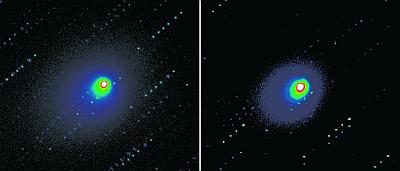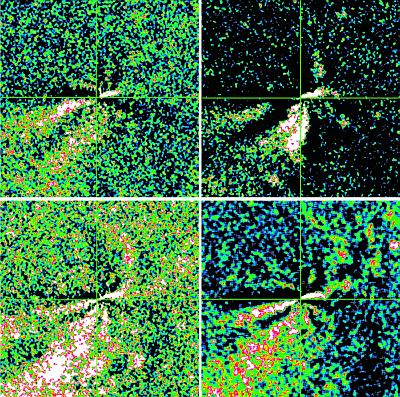 | |||
|
| Home > Public Information > ING Newsletter > No. 10, December 2005 > Deep Impact Observing at the Isaac Newton Telescope |
|
|
SCIENCE |
|
|
|
Previous: The Deep Impact Event as Seen from the Roque de Los Muchachos Observatory | Up: Table of Contents | Next: The SAURON View of the Nuclear Ring in M100
Article mirrored at: La Palma server | Cambridge server
Other available formats: PDF
Deep Impact Observing at the Isaac Newton Telescope
Stephen C. Lowry1, *, Andrew J. Coates2, Alan Fitzsimmons1, Geraint
H. Jones3 and Carey M. Lisse4
1: Queen’s University Belfast, UK; 2: Mullard Space Science Laboratory, University College London, UK; 3: Max-Planck-Institut für Sonnensystemforschung, Katlenburg-Lindau, Germany; 4: Johns Hopkins University Applied Physics Laboratory, MD, USA.
On July 3rd, 2005 the NASA Deep Impact impactor probe successfully separated from its mother craft onto a trajectory that would plunge the probe into the nucleus of comet 9P/Tempel1 at a velocity of 10kms–1. Impact occurred at 05:52 UT on July 4th, and the world looked on in amazement as the first spectacular images of the impact were received at Earth (more information: http://deepimpact.jpl.nasa.gov/). Meanwhile, observatories around the world and in space were closely monitoring the comet before, during, and after the impact. This was an unprecedented coordinated observational campaign, which included over 550 whole or partial nights of observation using 73 ground-based telescopes at 35 observatories. The Deep Impact mission was designed to have much of the mission-critical science done from Earth-based telescopes. These facilities would observe the comet’s evolution in wavelength regimes and timescales inaccessible to the spacecraft (The Tempel1 Observing Collaborators Team, 2005).
Comets are remnants of the early stages of the formation of our Solar System and thus contain the most pristine material from that era, as well as clues to its subsequent evolution. Whatever evidence we have into their internal composition comes either from remote observation and modelling of the dust and gases that are lifted off the surface, or from in-situ analysis of data from recent spacecraft flybys. Deep Impact was designed to provide a first look at the interior of a comet by striking the surface to expose the material underneath the opaque crust.
The target comet was 9P/Tempel1. This is one of a class of comets known as the Jupiter-family of comets, most of which are believed to have formed in the trans-Neptunian region. These objects have low inclination orbits and typically take less than 20 years to orbit the Sun. Their orbits are strongly influenced by Jupiter, hence their name. 9P/Tempel 1 orbits the sun once every 5.5 years, and the Deep Impact encounter was scheduled to take place at perihelion, when the comet was at 1.5 and 0.9 Astronomical Units from the Sun and Earth, respectively.
Observations at the Isaac Newton Telescope
The 2.5m Isaac Newton Telescope (INT) was used as part of the campaign. The observations from La Palma were very important for completing the time base coverage of the comet as it fell below the sky from the primary observing site at Mauna Kea, Hawaii. The INT team members include Dr. Stephen Lowry and Prof. Alan Fitzsimmons of Queen’s University Belfast, Dr. Andrew Coates of the Mullard Space Science Laboratory, Dr. Geraint Jones from the Max-Planck-Institut für Sonnensystemforschung, Katlenburg-Lindau, Germany, and Dr. Carey Lisse from Johns Hopkins University, USA.
Our observing slot ran from July 1st to July 7th, 2005. A period which overlapped the Deep Impact encounter allowing us three nights pre-impact and four nights post impact observing. Our strategy was to use the Wide Field Camera to obtain image mosaics up to 5 million kilometres along the projected anti-solar direction to look for ion-tail features that may have been produced as a result of the impact. The post impact observations quickly revealed that no such ion features were present, which was subsequently confirmed by other observers performing similar programs. With this in mind we decided to focus on deep optical imaging of the central gas and dust coma through UBVr'i'O+ filters. We were rather fortuitous in that the observing conditions remained beautifully clear for the entire duration of the observing run.
 |
| Figure 1. When comet Tempel 1 came into view from La Palma, some 16 hours after the NASA Deep Impact probe struck the comet, members of the La Palma Deep Impact Collaborating Observers Team were able to start tracking the target comet with the 2.5m Isaac Newton Telescope. Both images above are a combination of 7×20 second Sloan-Gunn r' (red) filter images which isolate the dust component of the coma. The image on the left was taken on July 3rd between 21:56 and 23:03 Universal Time, about 7 hours before impact. The image on the right was taken between 22:08 and 23:56 UT on July 4th, 16 hours after probe impact which occurred on July 4th 05:52 UT. The comet was seen to increase in brightness by a factor of two —as measured in the central pixel— before and after the impact as seen from this location. Even in these images the effects of the impact can be seen by the changing coma shape between the two images. North is up and East to the left. The field of view in both images is 340×340 arcseconds, which is equivalent to ~220,000×220,000km at the comet. [ JPEG | TIFF ] |
 |
| Figure 2. We applied Larson-Sekanina image processing techniques to the coadded r'-filter coma images from four of the nights to reveal the dramatic changes in the structure of the dust coma that resulted from the impact. Before impact on July 3rd (upper left panel), three jet structures can be seen to be emanating from the comet’s nucleus. On July 4th, just 16 hours after probe impact, the intensity of the jet/coma structures in the West and Southern direction increase dramatically (upper right panel). North is up and East to the left. On July 5th, new curved structures can be seen in the North-Western quadrant (lower left panel), possibly made visible by the extra material ejected into the coma from the impact. The structures seem to return to their pre-impact status on July 6th (lower right panel). The first three panels are directly comparable in terms of atmospheric seeing (variable seeing can complicate matters when comparing such processed images). The seeing on July 6th is actually much better than the other images. The images have been scaled to account for the slight extinction and geometry changes from night to night. Also, the images were taken under photometric conditions. Of course, nucleus rotation will need to be factored into this analysis, but even so, impact effects are still clearly seen in these images. The field of view in every image is 95×95 arcseconds, which is equivalent to ~62,000×62,000km at the comet. [ JPEG | TIFF ] |
When we imaged the comet on July 4th, about 16 hours after the impact, the comet was seen to have increased in brightness by a factor of two —as measured in the central pixel— compared to the July 3rd pre-impact levels. Some dramatic changes were seen in the dust coma which are shown in Figures 1, 2 and 3. The Deep Impact event did not create a new period of sustained cometary activity, and in many ways the artificial impact resembled a natural outburst (The Tempel1 Observing Collaborators Team, 2005; Lara et al., 2005). The observed optical properties of the dust coma from this abundant data set will be modelled by our team.¤
 |
| Figure 3. These dramatic images of the expanding and dissipating ejecta plume were obtained by dividing the July 4th, 5th, and 6th coadded images of the comet by the pre-impact image on July 3rd. North is up and East to the left. The plume expands mostly into the South-Western quadrant, and appears to be decelerating at a non-uniform rate. The dust particles at the leading edge of the plume, are expanding at a rate of ~210ms–1 (±10%) on July 4th (measured at a Position Angle of 225°). The field of view in every image is 190×190 arcseconds, which is equivalent to ~123,000×123,000 km at the comet.[ JPEG | TIFF ] |
References:
The Tempel 1 Observing Collaborators Team, 2005, Science,
310, 265. [ ADS
| First citation in text ]
Lara L. et al., 2005, in preparation. [ First citation in text
]
*: Email contact: Stephen Lowry (
 )
)
| Top | Back |
|

